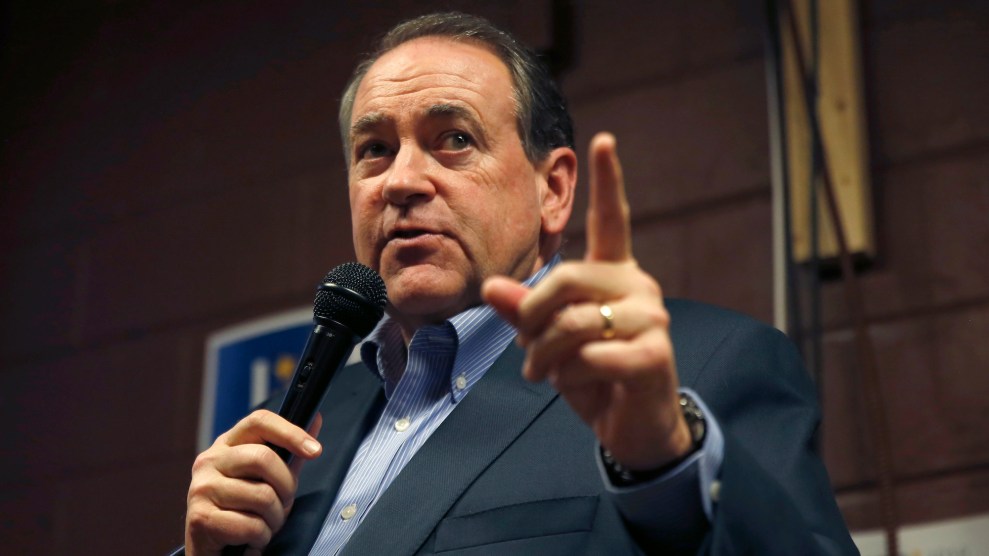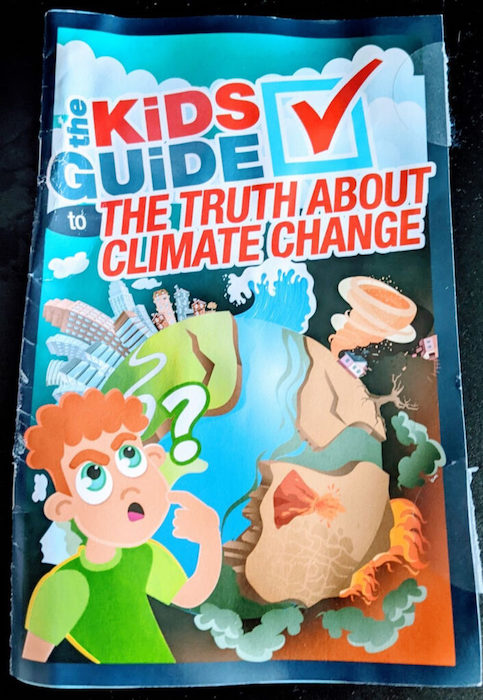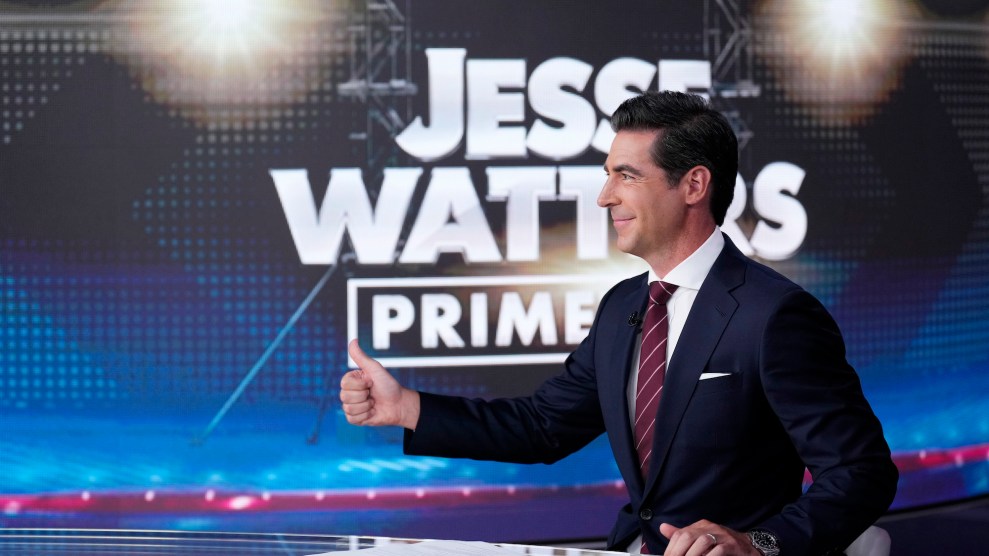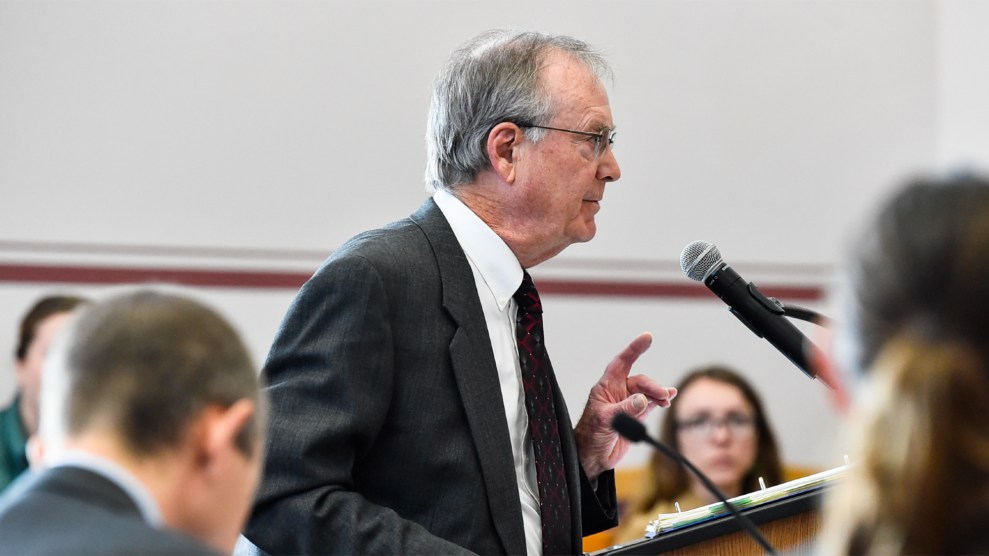
Kiichiro Sato/AP
This story was originally published by Inside Climate News and is reproduced here as part of the Climate Desk collaboration.
Beverly Grimmett thought the kids magazines she saw stacked on a coworker’s desk this spring were perfectly innocent, until she picked one up.
“My stomach turned,” Grimmett said.
The guides were decorated in bright colors and cheerful cartoons, with titles like, The Kids Guide to Socialism, The Kids Guide to Our One Nation Under God, and, finally, The Kids Guide to the Truth About Climate Change.
Grimmett, who works in construction project management at a six-person office in Norfolk, Virginia, had happened upon one of former Gov. Mike Huckabee’s educational ventures, a series called The Kids Guide from Ever Bright Media, the children’s publishing company he founded.
The company launched its children’s guide to climate change this spring, and has spent thousands of dollars on TV and social media advertising that prominently features Huckabee himself. The guide argues that the climate crisis is not as dire as mainstream media would have you believe, but it does not list its authors or what their credentials might be. And though its title claims to present the “truth,” science educators and climate researchers have found the guide to be full of factual inaccuracies.
“It’s propaganda,” said Glenn Branch, deputy director of the National Center for Science Education, a nonprofit organization dedicated to promoting fact-based science education, including about evolution and climate change. “It’s highly slanted with a clear ideological message, and it’s very unreliable as a guide to climate change for kids.”

As climate debates remain polarized and politicized, Huckabee’s guide is part of a small but determined contingency of climate disinformation materials marketed to children and families. It also fits into a new niche in the broader landscape of climate skepticism. In recent years, efforts to erode public confidence in mainstream climate science—which have long been orchestrated by the fossil fuel industry—have trended away from outright denial of the climate crisis to a more nuanced narrative that doesn’t deny that the planet is warming but instead suggests it’s been overblown by scientists, politicians, and mainstream media, and advocates for continued use of fossil fuels.
Climate skeptics’ arguments have been consistently debunked by scientists, but misinformation from the oil and gas industry and its proponents has continued to proliferate and seek out new audiences.
Grimmett said her coworker bought the guides—including The Kids Guide to the Truth About Climate Change—for his eight- and 11-year-old children. She borrowed them to show her own 12-year-old son, and was alarmed by what she understood to be blatant misinformation.
“There’s not enough truth mixed in with the lies for me to even think that something like this should be published,” Grimmett said.
The Kids Guide series is being marketed to parents as an alternative to mainstream education, which Huckabee’s ads claim will send their children into a false panic about climate change. Branch said the guide ignores key scientific advances and uses factual information in a misleading way—on one page, it notes that China’s greenhouse gas emissions are 2.5 times higher than the US, ignoring the fact that per capita emissions in the US are actually close to twice those in China, and that the US remains the largest historic emitter of climate warming gasses.
“Of course we need to protect our home,” the guide remarks on page four in an acknowledgement of environmental responsibility that advocates for recycling and energy conservation. But when it moves on to describing climate change, it asserts that “the climate has always changed—long before humans walked the earth—and it continues to change.”
Such rhetoric, a hallmark of many media campaigns that minimize the severity of climate change, ignores the scientific consensus that temperatures in the past century rose almost 10 times faster than the average warming after ice ages during the past million years, and that the increasing heat correlates with global carbon emissions, which are higher than they’ve ever been in human history. Warming during the next century is projected to progress 20 times faster than it did in the last two million years.
The guide has little sourcing of the information it presents—the only citations offered are for graphics, and even these are often as vague as a file name or organization title, making it difficult for a reader to track down the original source.
The visuals used in the guide are even more blatantly misleading than its text, Branch noted. One graph, titled “Thousands of Years of Carbon Dioxide Levels,” spans 400,000 years ago until “present day,” and is summarized with the conclusion, “looking back in time, carbon dioxide levels have always gone up and down.”
But the data the graph labels as “present day”—peaking at a little over 280 parts per million—actually represents levels from 2,300 years ago, around 391 BC, Branch pointed out. The vast majority of the carbon dioxide driving climate change has been emitted only since the Industrial Revolution, with atmospheric CO2 concentrations currently over 420 parts per million, higher than any data point included on the graph, which has a scale that only goes up to 300 parts per million.
The guide’s rhetoric fits into recent trends in select media that seek to minimize the severity of climate change and delay action, accepting that the climate is warming, but downplaying the magnitude of impacts and disputing human influence on the climate, said Syracuse University Biology and Earth Science Professor Jason R. Wiles.
“What science is presented is cherry-picked and used to cast doubt on what is actually a very robust and well-evidenced scientific consensus,” Wiles said. “Apart from its being very misleading, my main concern is that it fosters complacency by promoting the notion that climate change is not as dire a problem as it truly is.”
“You may have heard from your kids that the earth is soon going to be an uninhabitable hellscape,” says Huckabee in one of The Kids Guide’s ads, standing in front of what looks like a greenscreen of a blazing forest fire. “That’s because some of their teachers and the media have an agenda.”
The advertisement goes on to describe how the guide will answer kids questions about climate change “truthfully,” and sends viewers to keepkidscool.com, where they can sign up for a “free” gift bundle that includes the guide, with an advertised shipping cost of only $1. Ever Bright Media, however, has faced frequent customer complaints and accusations of hiding fees and charges, obscuring terms and agreements and automatically enrolling people into a magazine subscription program that costs $19.95 plus sales tax every three to four weeks, plus a monthly magazine charge of $7.95.
Since Huckabee’s term as governor of Arkansas ended in 2007 he’s had two failed bids for president but has mostly worked in media. His talk show, Huckabee, ran on Fox News from 2008 to 2015 before moving to Trinity Broadcast Network, a Christian outlet.
Huckabee, who is an ordained Southern Baptist minister, founded Ever Bright Media in 2009, and launched The Kids Guide in 2020. The series has more than 40 guides focused on history and current events, plus a series on the Bible. According to data gathered by Media Matters—a nonprofit research center that monitors misinformation in US media—the company spent $83,300 on Facebook ads from January 1 to June 6, 2023 and has appeared hundreds of times in ads on Fox News.
In 2015, Huckabee jokingly compared climate change to “a sunburn.” Last year, in a video on his TBN talk show’s YouTube channel, he derisively belittled a doctor for citing climate change as a factor in a heat related illness, despite scientific consensus that increased frequency and severity of heat-related illnesses and death are in fact tied to global warming.
Alison Fisher, who reviewed the guide for Media Matters, said one of the main dangers of materials that deny the severity of climate change like Huckabee’s guide is that they deliberately undermine children’s scientific education. Such materials also take away crucial context for a generation that is already experiencing the impacts of climate change, she added.
“They’re not just trying to create climate skeptics,” Fisher said. “They’re actually eroding trust in science and the scientific community.”
Branch said that the guide seems to be targeting a small but receptive audience, so its impact may not be widespread. But for some educators, Huckabee’s stamp of approval is a green flag.
One Washington state educator, who asked to remain anonymous, uses various Kids Guides with her middle school students, and said she was initially interested in the guide because of Huckabee’s involvement. “I consider myself middle class, and he comes across as a middle class kind of person,” the educator said, adding that she felt Huckabee seemed reliable based on past speeches. “If he would recommend something, I would look into it.”
When asked about the reliability of the guides’ sourcing, the educator said she uses them with her students as a jumping off point for research, not as a definitive source, and noted that her students found them fun and engaging. “It doesn’t go into all the scary stuff,” she said.
The main thesis of the climate change guide seems to be that scientists and media are trying to create unnecessary panic, and this rhetoric fits into a broader effort to introduce materials denying the severity of climate change into American education.
In 2017, the Heartland Institute, a conservative think tank that rejects the scientific consensus on climate change and the health impacts of smoking, sent 350,000 copies of its publication, Why Scientists Disagree About Global Warming, to teachers across the country. The campaign had mixed results, as some teachers used the materials to teach about the dangers of propaganda.
This year, Heartland sent out copies of a new publication called Climate at a Glance, which the institute claims “provides the data to show the earth is not experiencing a climate crisis,” to 8,000 teachers. Other groups, like the CO2 Coalition, a nonprofit foundation that focuses on CO2’s benefits, and PragerU, a conservative advocacy and media organization, have also targeted children with materials questioning the existence or severity of the climate crisis.
Big Oil’s climate misinformation machine has been operating for decades, despite the industry’s early awareness of the crisis. In 1965, American Petroleum Institute President Frank Ikard gave a speech directly acknowledging that burning fossil fuel would cause climate change, saying “there is still time to save the world’s peoples from the catastrophic consequence of pollution, but time is running out.” In 1978, Exxon Mobil’s own scientists published an internal report confirming that rising carbon emissions would lead to global warming, and by 1980 industry giants were discussing the “globally catastrophic effects” of temperature rise.
Instead of pulling back operations, the oil industry outwardly denied the science it had internally confirmed, continuing to chase growth and profits and funding a widespread campaign of disinformation that infiltrated government, research institutions, media and schools. In 1998, as climate action drew global attention with the Kyoto Protocol, the API wrote in a memo that “unless ‘climate change’ becomes a non-issue, meaning that the Kyoto Protocol is defeated and there are no further initiatives to thwart the threat of climate change, there may be no moment when we can declare victory for our efforts.”
Today, Big Oil continues to pour billions of dollars into anti-climate legislation, funnel high dollar donations to candidates in both major parties and market pro-industry curriculum to teachers in need. Huckabee is no exception: Like many candidates, his failed 2016 presidential campaign’s top donors included oil and gas companies and private equity firms that are heavily invested in fossil fuels. And the fossil fuel industry’s misinformation machine has spawned a slew of independent organizations and individuals driving their own misinformation campaigns on the climate crisis.
For the most part, Huckabee’s materials don’t seem to be targeting schools, instead providing parents with alternatives to mainstream education and doing outreach to homeschoolers. Still, in 2020, the Arkansas Department of Education used emergency COVID funds to strike a $260,000 deal with Ever Bright Media for The Kids Guide to Coronavirus, one version of which reportedly quoted incorrect information about the effectiveness of wearing masks to inhibit transmission of the disease. The Arkansas DOE also purchased a constitutional booklet from Ever Bright Media, according to their communications department.
Other aligned materials, however, are making it into public school classrooms. Melissa Lau, an Oklahoma science educator with over two decades of teaching experience, said she’s seen a general lack of climate change-related materials in classrooms. The vast majority of teachers in her state avoid the topic, she said. Still, she added that under-resourced schools and teachers often jump at free curriculum or equipment opportunities for lack of better options, even when they come with unreliable or harmful information.
Lau, who is a teacher ambassador for NCSE, said many of her colleagues receive free lab equipment and curriculum material from the Oklahoma Energy Resources Board—an oil and gas-funded advocacy organization that offers teachers free educational materials with pro-petroleum messaging and $50 stipends in exchange for attending events.
Like many of her students, Lau has family working in the oil and gas industry, she said, so she understands that discussions around the energy transition are often personal or delicate. But the fear tactics around job losses that are central in some pro-industry materials can obscure scientific fact, she said. “That’s the hard part about disinformation,” Lau said. “Unless you’re just attuned to it, it’s difficult to identify cherry picking of data.”
At a moment when children as young as five are suing their governments for inaction on climate change, it seems like materials denying the severity of global warming would face an uphill battle. But information provided in educational contexts can still have significant influence, according to researchers.
In California’s Bay Area, a 2021 study by North Carolina State University Professor K.C. Busch found that students who read texts that framed the climate crisis with uncertainty reported lower levels of certainty themselves, regardless of how much prior knowledge they had around climate change.
Even the best science textbooks lag behind current research, though Busch said the textbooks she encountered about climate change—even in the liberal Bay Area—went beyond being out of date and were genuinely inaccurate.
De-briefing with the students who participated in her study, Busch found that students hadn’t considered the possibility that their textbooks might not be entirely accurate.
Busch said this makes it even more important not only to ensure accurate information in textbooks, but also to teach students critical thinking and how to evaluate the credibility of sources themselves.
“It kind of blew their minds that the textbook from their [class] might not be accurate,” Busch said.
Lau is working to address the problem of scientific literacy within her own district, running a workshop with other high school science teachers on how to determine if instructional materials are high-quality enough to use in the classroom.
Barbara Denson, a civil engineer who writes under the name B.B. Denson, has written two children’s books that advocate for the continued burning of fossil fuels and pushes a message she calls “climate defiant.” Denson doesn’t deny that climate change is happening, but she said she does not believe that human influence is a primary driver of these changes.
Denson worked in the oil and gas industry before becoming an advocate for clean energy. Now, she advocates against renewable energy. One turning point was listening to a presentation by Patrick Moore, director of the CO2 Coalition—a nonprofit organization that argues for the importance of carbon dioxide, Denson said. Moore, who was an early leader with Greenpeace, left the environmental advocacy organization in 1986 due to political disagreements and has since consulted in the timber, mining and nuclear industries, among others.
Denson decided to write children’s books because she felt her message needed to be simplified to a level that a child could understand, and she didn’t see anyone doing that. She said she doesn’t expect children reading her books to form opinions about climate change, but instead hopes to influence families.
“Ninety-nine point nine nine percent of what everybody hears is the other side of the story, so there’s only a handful of us scientists that are kind of digging in our heels,” the engineer said. She added that she believes mainstream climate science is only a theory rather than documented fact.
“The fact that we are releasing carbon dioxide and making plants healthier is a really good thing,” Denson said.
One of Denson’s books, called Carbon Comes Out of the Closet, follows Gary the Go-Cart, an anthropomorphic car that drives around while learning about carbon dioxide. First, Gary is bombarded with messaging that calls for sequestration and taxation of CO2, and he tries to sequester his own emissions. Later in the story he comes across a tree of apples that tell him they need more carbon—meaning CO2—to grow bigger, so Gary decides to “spray” carbon into the air and onto the ground around the trees and other plants.
“The plants were all much healthier,” the text reads. “With carbon in the atmosphere, everybody wins.”
This is an argument often used by the CO2 Coalition, one of Denson’s main influences, whose founders previously worked in the research laboratories of Exxon and Shell.
“It’s one of those grains of scientific truth opening up an avalanche of misinformation,” Wiles said, explaining that carbon dioxide emissions from human activities have reached a rate that’s far greater than our forests and plant communities can sequester, while deforestation and biodiversity loss only add to that discrepancy.
Huckabee’s guide acknowledges the warming effects of CO2, but argues that its fluctuation is natural and that the US, “thanks to capitalism, free thinkers and investors,” has “helped turn the climate tide.”
The US, which houses a little over 4 percent of the world’s population, has contributed 20 percent of global emissions since 1850.
As book banning and partisan calls to censor current and historic events from public school curriculums grow, climate misinformation is only one piece of a broader politicization of information in education. Grimmett, who returned The Kids Guides to her coworker after looking through them at home, said it makes her fearful for her son’s generation.
“So much of my heart and hope is hanging on the kids,” Grimmett said. “These materials…will make that generation be just as split as we are now.”
Mike Huckabee’s office and Ever Bright Media did not respond to multiple requests for comment.











